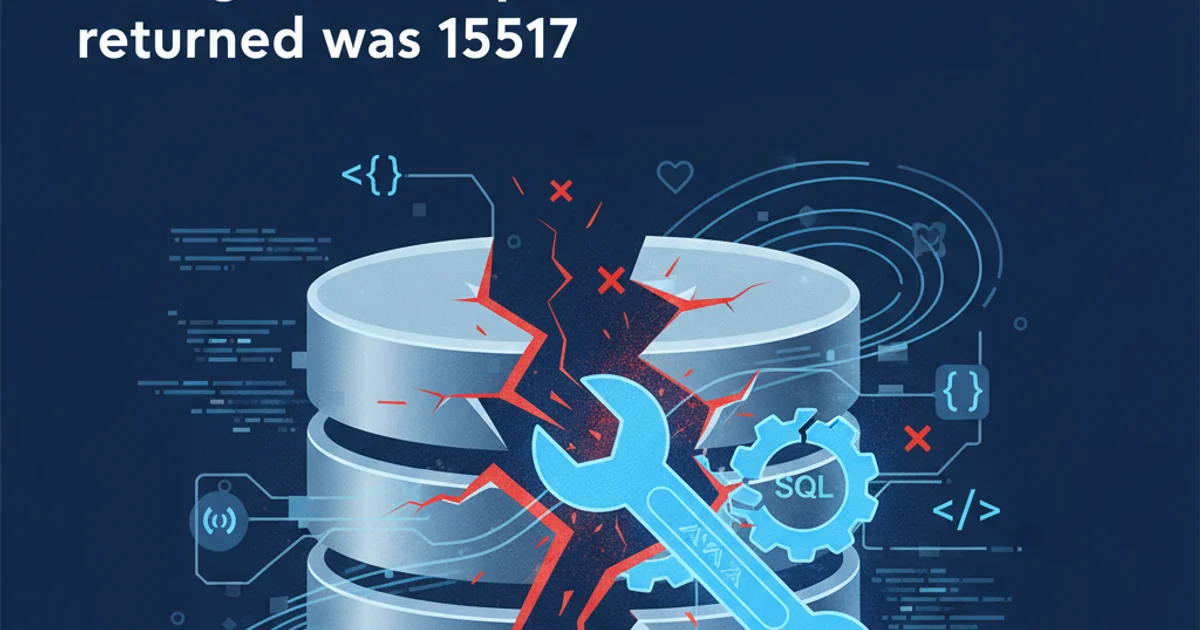Could not update the metadata that indicates database X is enabled for Change Data Capture. The e...
Resolving SQL Server Error 15517: CDC Metadata Update Failure

This article provides a comprehensive guide to understanding and resolving SQL Server error 15517, which occurs when updating Change Data Capture (CDC) metadata. Learn common causes and practical solutions.
Encountering error 15517 in SQL Server can be a frustrating experience, especially when you're trying to enable or manage Change Data Capture (CDC) on a database. This error message, "Could not update the metadata that indicates database X is enabled for Change Data Capture. The error returned was 15517," typically points to a permissions issue related to database ownership. CDC relies heavily on the sys.databases catalog view and specific system stored procedures, which require elevated privileges to modify. This article will delve into the root causes of this error and provide clear, actionable steps to resolve it, ensuring your CDC setup proceeds smoothly.
Understanding Error 15517 and Its Causes
Error 15517 in SQL Server is a security-related error. It signifies that the current user attempting to modify CDC metadata does not have the necessary permissions to impersonate the database owner. When CDC is enabled, SQL Server internally uses the sys.sp_cdc_enable_db stored procedure, which in turn tries to execute certain operations as the database owner. If the user enabling CDC is not the database owner, or if the database owner login no longer exists or is disabled, this impersonation fails, leading to error 15517.
The most common scenarios leading to this error include:
- Incorrect Database Owner: The login set as the database owner (
dbo) might not exist, be disabled, or lack the necessary server-level permissions. - Insufficient User Permissions: The user attempting to enable CDC does not have
sysadminprivileges ordb_ownerrights, and cannot impersonate the database owner. - Database Restoration Issues: After restoring a database from another server, the
dbouser might be orphaned or mapped to an incorrect login, causing permission discrepancies. - Login Mismatch: The login associated with the database owner SID (Security Identifier) does not match an existing server-level login.
flowchart TD
A[User attempts to enable CDC] --> B{Execute `sys.sp_cdc_enable_db`}
B --> C{SQL Server attempts to impersonate DB Owner}
C -- Impersonation Fails --> D[Error 15517: Could not update metadata]
C -- Impersonation Succeeds --> E[CDC Metadata Updated Successfully]
D -- Root Cause: --> F[DB Owner Login Missing/Disabled]
D -- Root Cause: --> G[User Lacks `sysadmin`/`db_owner`]
D -- Root Cause: --> H[Orphaned DB Owner after Restore]Flowchart illustrating the process leading to SQL Server Error 15517 during CDC enablement.
Verifying Database Owner and Permissions
Before attempting any fixes, it's crucial to identify the current database owner and verify the associated login's status and permissions. You can do this by querying the sys.databases catalog view and checking the owner_sid column. Then, cross-reference this SID with server-level logins in sys.server_principals.
USE master;
GO
SELECT
d.name AS DatabaseName,
suser_sname(d.owner_sid) AS DatabaseOwnerLogin,
d.owner_sid
FROM
sys.databases AS d
WHERE
d.name = 'YourDatabaseName';
GO
-- Check if the login exists and is enabled
SELECT
name AS ServerLoginName,
is_disabled
FROM
sys.server_principals
WHERE
sid = (SELECT owner_sid FROM sys.databases WHERE name = 'YourDatabaseName');
GO
SQL query to identify the database owner and check its server login status.
sa or a dedicated, highly privileged login (like a service account) as the database owner for system databases or databases requiring CDC. Avoid using Windows groups or individual Windows users as database owners if possible, as this can sometimes complicate permission management.Resolving Error 15517: Step-by-Step Solutions
The primary solution involves ensuring that the database owner is a valid, enabled login with sufficient permissions. The most straightforward way to achieve this is to change the database owner to sa or another sysadmin privileged login.
1. Connect with sysadmin Privileges
Ensure you are connected to SQL Server using a login that has sysadmin server role privileges. This is crucial for changing database ownership.
2. Change Database Owner to sa
Execute the ALTER AUTHORIZATION statement to change the database owner to sa. Replace YourDatabaseName with the actual name of your database.
3. Verify Database Owner
Re-run the verification query from the previous section to confirm that sa is now the database owner.
4. Enable CDC
Attempt to enable CDC again using sys.sp_cdc_enable_db. This time, it should succeed as sa has the necessary permissions for impersonation.
USE YourDatabaseName;
GO
-- Change the database owner to 'sa'
ALTER AUTHORIZATION ON DATABASE::[YourDatabaseName] TO [sa];
GO
-- Now, try to enable CDC
EXEC sys.sp_cdc_enable_db;
GO
SQL commands to change database owner and then enable CDC.
sa is a powerful operation. Ensure you understand the security implications. If sa is not desired as the permanent owner, you can change it back to a more appropriate, but still privileged, login after CDC is enabled and configured.Alternative: Mapping Orphaned Users
If the issue stems from an orphaned database user (e.g., after a database restore), you might need to map the dbo user to an existing server login. This is less common for error 15517 specifically related to the database owner SID, but it's a related permission issue that can occur.
USE YourDatabaseName;
GO
-- Check for orphaned users (optional, but good practice)
EXEC sp_change_users_login 'Report';
GO
-- If 'dbo' is orphaned, map it to an existing server login (e.g., 'sa')
-- This is typically for database users, not the database owner itself.
-- For database owner, ALTER AUTHORIZATION is preferred.
-- EXEC sp_change_users_login 'Auto_Fix', 'dbo'; -- Use with caution
-- Or manually map:
-- ALTER USER dbo WITH LOGIN = sa;
GO
SQL commands to check for and potentially fix orphaned database users.
By systematically checking the database owner and ensuring the associated login has the necessary sysadmin privileges, you can effectively resolve error 15517 and successfully enable Change Data Capture on your SQL Server databases. Always prioritize security best practices when managing database ownership and permissions.